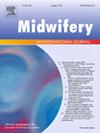Midwives’ perspectives on women's dietary intake during pregnancy: A systems thinking approach
IF 2.6
3区 医学
Q1 NURSING
引用次数: 0
Abstract
Background
Prenatal nutrition status and maternal dietary behaviours are known to impact maternal and child health outcomes. Aim: We aimed to inform strategies for improving prenatal diet quality and their integration into pregnancy care.
Method
Group Model Building (GMB) workshops were conducted with midwives from six health services. A Causal Loop Diagram (CLD) was developed to illustrate how the factors contributing to poor nutrition during pregnancy were interconnected and influenced each other and to identify priority action areas. Workshops were recorded and transcripts thematically analysed to provide a deeper understanding of the challenges of dietary advice provision and intervention opportunities.
Results
The GMB process created a CLD that included 51 factors that were perceived to be driving poor dietary intake in pregnancy. These were grouped into five priority areas for action: knowledge and education, food availability and access, personal and family circumstances, health system, and care. Thematic analysis of the workshop transcripts revealed four major themes related to midwives’ perspectives on the challenges associated with delivering dietary advice in pregnancy care: hospital service provision, pregnancy care clinicians, psychosocial factors affecting women, and maternal diet and health. Intervention targets were identified as continuity of care, nutrition education, guidelines and resources, personalised dietary advice, dietary data collection, and dietitian referrals.
Conclusion
Midwives’ perspectives on the drivers of poor prenatal nutritional intake were multifaceted, spanning the personal, environmental and health system levels. Nutrition interventions should consider the health system and service context, along with pregnant women's dietary knowledge and education, access to healthy food, social, cultural, and personal circumstances, and clinical care experience.
助产士对怀孕期间妇女饮食摄入的看法:系统思考方法
众所周知,产前营养状况和孕产妇饮食行为会影响孕产妇和儿童的健康结果。目的:我们旨在为改善产前饮食质量及其与妊娠护理的结合提供策略。方法与来自6个卫生服务机构的助产士进行小组模型构建(GMB)讲习班。制定了因果循环图,以说明导致怀孕期间营养不良的因素如何相互联系和相互影响,并确定优先行动领域。对研讨会进行了记录和主题分析,以便更深入地了解提供饮食建议和干预机会的挑战。结果GMB过程创建了一个CLD,其中包括51个被认为导致孕期饮食摄入不良的因素。这些问题被分为五个优先行动领域:知识和教育、粮食供应和获取、个人和家庭情况、卫生系统和护理。对讲习班记录的专题分析揭示了与助产士对在妊娠护理中提供饮食咨询相关挑战的看法有关的四个主要主题:医院服务提供、妊娠护理临床医生、影响妇女的社会心理因素以及产妇饮食和健康。干预目标确定为护理连续性、营养教育、指南和资源、个性化饮食建议、饮食数据收集和营养师转介。结论助产士对产前营养摄入不良的驱动因素的看法是多方面的,包括个人、环境和卫生系统层面。营养干预措施应考虑卫生系统和服务环境,以及孕妇的饮食知识和教育、获得健康食品的途径、社会、文化和个人情况以及临床护理经验。
本文章由计算机程序翻译,如有差异,请以英文原文为准。
求助全文
约1分钟内获得全文
求助全文
来源期刊

Midwifery
医学-护理
CiteScore
4.50
自引率
7.40%
发文量
221
审稿时长
13.4 weeks
期刊介绍:
Midwifery publishes the latest peer reviewed international research to inform the safety, quality, outcomes and experiences of pregnancy, birth and maternity care for childbearing women, their babies and families. The journal’s publications support midwives and maternity care providers to explore and develop their knowledge, skills and attitudes informed by best available evidence.
Midwifery provides an international, interdisciplinary forum for the publication, dissemination and discussion of advances in evidence, controversies and current research, and promotes continuing education through publication of systematic and other scholarly reviews and updates. Midwifery articles cover the cultural, clinical, psycho-social, sociological, epidemiological, education, managerial, workforce, organizational and technological areas of practice in preconception, maternal and infant care.
The journal welcomes the highest quality scholarly research that employs rigorous methodology. Midwifery is a leading international journal in midwifery and maternal health with a current impact factor of 1.861 (© Thomson Reuters Journal Citation Reports 2016) and employs a double-blind peer review process.
 求助内容:
求助内容: 应助结果提醒方式:
应助结果提醒方式:


